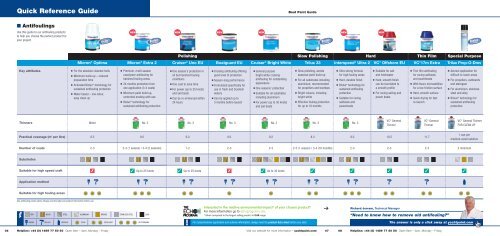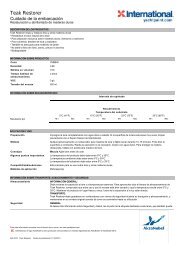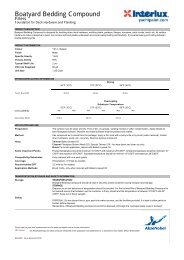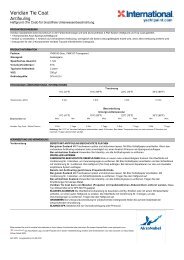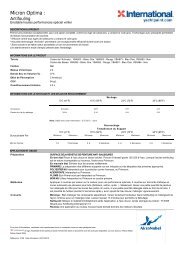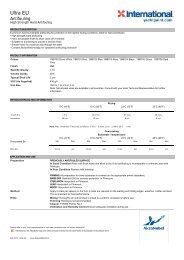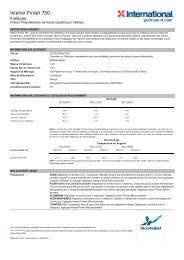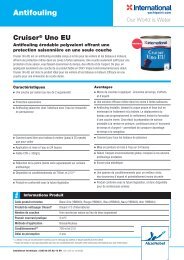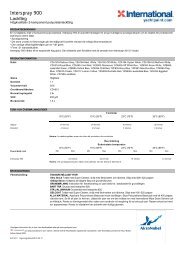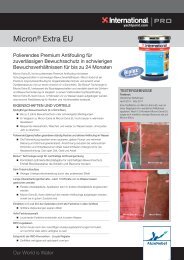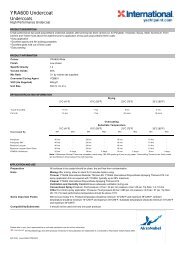Boat Paint Guide - Yachtpaint.com
Boat Paint Guide - Yachtpaint.com
Boat Paint Guide - Yachtpaint.com
- No tags were found...
Create successful ePaper yourself
Turn your PDF publications into a flip-book with our unique Google optimized e-Paper software.
Before You Start<strong>Boat</strong> <strong>Paint</strong> <strong>Guide</strong>n Health & SafetyProviding health and safety precautions for paintproducts is a legal requirement and forms a specificsection on our labels. However, the wording is laiddown by law and is often difficult to understand.This section is intended to help you interpret andunderstand the symbols and phrases you will find inour literature and on our product labels. We’ve alsoincluded some further information to make applyingpaint a safer job.Before starting work always read the label. Eachtin will display a number of warning symbols andwritten warning phrases which will quickly indicatethose areas where particular care should be taken.Other general safety precautions are detailed belowand will help should any problem occur whilst usingour paints.Personal HealthAvoid ingestionFood and drink should not be prepared or consumedin areas where paint is stored or is being used. Incases of accidental paint ingestion seek immediatemedical attention. Keep the patient at rest, do NOTinduce vomiting.Avoid inhalationThe inhalation of solvent vapour from paint, or dustfrom sanding, can be reduced by the provision ofadequate ventilation or extraction. If this is notsufficient, or if specifically stated on the label,suitable respiratory protection should be used.Wear a cartridge type respirator when abrading oldantifoulings – never burn off or dry-sand antifoulingsas this may create harmful fumes or dust.In badly ventilated areas wear an air-fed hoodor cartridge respirator with an organic vapourfilter. Solvent fumes are heavier than air. Breathingthese fumes can make you dizzy, feel drunk andheadachy and could even result in collapse.Read the label carefully and ensure that there<strong>com</strong>mended protection is worn.Spray painting creates additional health hazards.Spray mists should not, under any circumstances,be inhaled. Read the label carefully and ensurere<strong>com</strong>mended protection is worn; generally anair-fed hood is the best protection as it providesa fresh air feed to the user.Avoid eye contactEye protection should be used during paintapplication and when there is any risk of paintsplashing on the face. Safety glasses or goggles areinexpensive, available from many DIY stores, andare well worth wearing. Use eyewear that <strong>com</strong>plieswith EN 166. If material does contaminate the eye,it is re<strong>com</strong>mended that the eye is flushed withclean fresh water for at least 15 minutes, holdingthe eyelids apart, and medical attention sought.Avoid skin contactSkin irritation can occur from contact with paintproducts. You should, therefore, always wearprotective gloves and protective clothing whenapplying or mixing any paint products. Overalls,which cover the body, arms and legs, should beworn. Skin cream, of a non-greasy barrier type, maybe used on the face. Do NOT use petroleum jelly asthis can help the absorption of paint into the body.Remove rings and watch straps before <strong>com</strong>mencingwork, as these can trap paint particles next to theskin. Remove any paint that does get onto theskin by washing with warm water and soap or anapproved skin cleanser. After washing, apply a skinconditioner. Never use solvent or thinners to cleanthe skin.Product LabellingThe following warning symbols are used on ourproduct labels. Always read the information onthe label thoroughly, before you start.CorrosiveThis material will attack the eyesand skin and can give you burns.Extremely/Highly FlammableA spark or cigarette end will starta fire, more easily than with petrol.<strong>Paint</strong> or thinners in tins, or vapoursin the air, can catch fire or explode.Harmful/IrritantThis material may harm you throughskin contact, from breathing in oringesting. The wording will indicatewhich.Dangerous for the EnvironmentThis material is toxic to aquaticorganisms and may cause longtermadverse effects in the aquaticenvironment.Risk of fire or explosionMost paints contain organic solvents – some of whichevaporate into the air upon opening the container.Any dangers can be reduced if a few simpleprecautions are taken:n Avoid naked flames where paint is being stored,opened or appliedn Do not smoken Store paint in a well-ventilated, dry placeaway from sources of heat and direct sunlightn Keep the tin tightly closedn Avoid sparks from metals, electrical appliances beingswitched on and off, or faulty electrical connectionsn Do not leave paint soaked rags lying around,in the pockets of overalls or in waste bins. Sometypes of paint can dry out and auto-ignite.Richard JerramTechnical Manager“Need more expert adviceon working safely withour products?”The information shown in this section is providedas a basic guideline only. To ensure you haveaccess to up-to-date information on personaland environmental health and safety andchoosing the most suitable tools and equipment,we now publish more <strong>com</strong>prehensive‘Before You Start’ information on our website.Alternatively, you can always call us via yourlocal International help line number, where amember of our Technical Support Team willbe pleased to provide you with information andadvice, tailored to your particular needs.Click or call – expert adviceat your fingertipsFor further information on Personal Protective Equipment, visit yachtpaint.<strong>com</strong>04 Helpline: +44 (0) 1489 77 50 50 Open 9am – 4pm, Monday – FridayVisit our website for more information – yachtpaint.<strong>com</strong> 05


